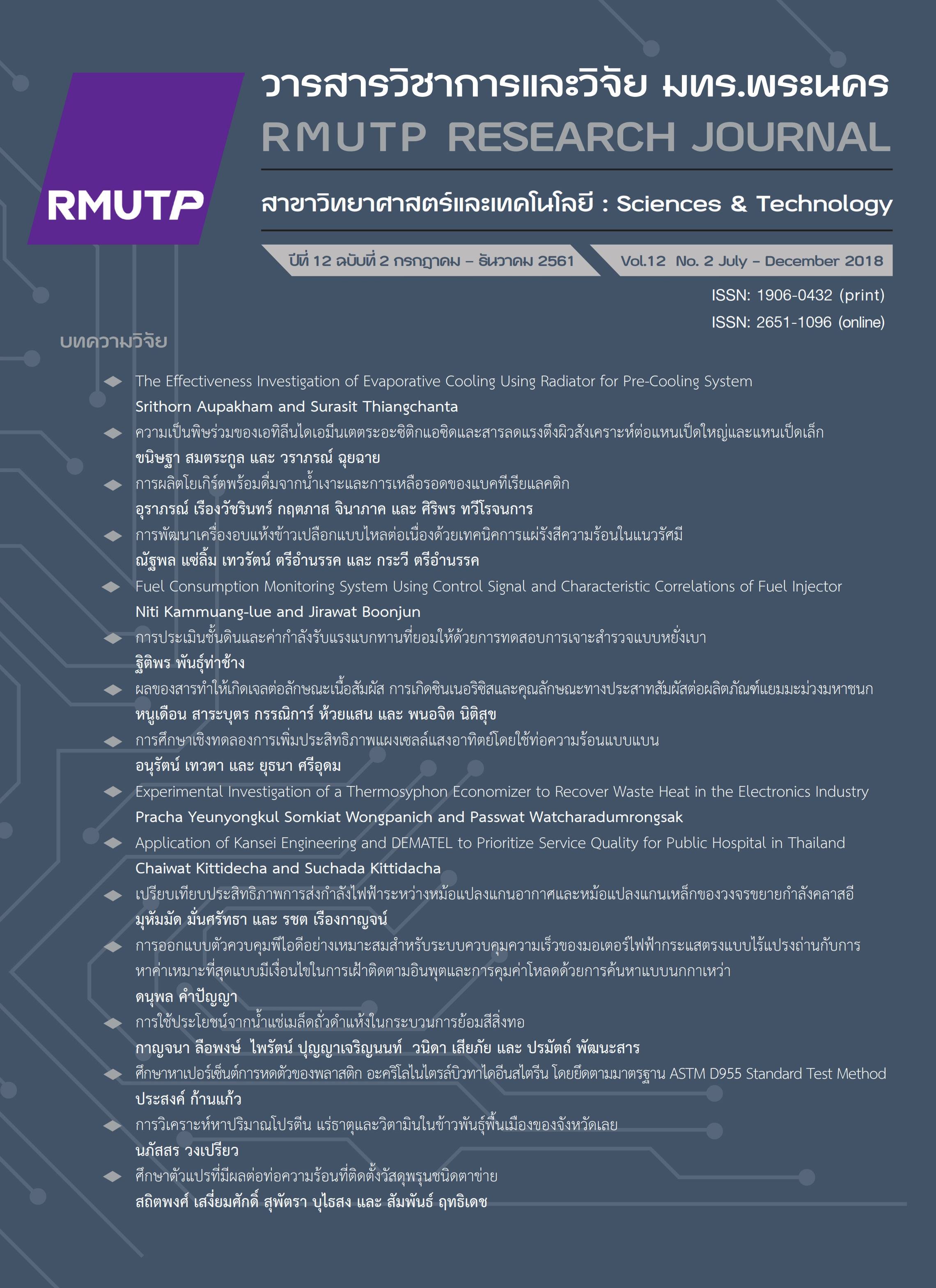The production of drinking yoghurt from rambutan juice and survival of lactic bacteria
Main Article Content
Abstract
This study aimed to investigate an appropriate for yoghurt production including the amount of concentrated rambutan juice (0, 10, 15, 20 and 25% (w/w)), the effect of concentrated rambutan juice on physical and chemical, microbiological and sensory characteristics, lactic acid bacteria survival and appropriate of syrup for drinking yoghurt production. It was found that concentration concentrated rambutan juice no effect in color (L*,a*) of the yoghurt (p>0.05). Meanwhile, it was significantly different (p≤0.05) for b*. Viscosity were increased. Yoghurt added 15% concentrated rambutan juice had 88% survival rate of lactic bacteria after stimulated digestive system. The results showed that optimal formula of drinking yoghurt were 10% syrup. Drinking yoghurt stored in the refrigerator at 4±1 oC for 15 days was evaluated and found that LAB survival numbers were 9.90 log CFU/ml.
Article Details
References
[2] H. Cormier, E. Thifault, V. Garneau, A. Tremblay, V. Drapeau and L. Perusse, “Association between yogurt consumption, dietary patterns, and cardio-metabolic risk factors,”European Journal of Nutrition, vol 55, pp. 577-587, 2015.
[3] R. Fuller “Probiotics in man and animals,”Journal of Applied Bacteriology, vol. 66, pp. 365-378, 1989.
[4] Notification of the Ministry of Public Health. Use of Probiotic Microorganisms in Foods. Published in the Government Gazette Vol. 128, Special Part 86 Ngor, August 2011.
[5] Siam business, Section: Marketing-CSR, vol. 19 (1385), pp. 22, 13-15 March. 2013.
[6] M. B. Akin, M. S. Akin, and Z. Kirmaci, “Effects of inulin and sugar levels on the viability of yogurt and probiotic bacteria and the physical and sensory characteristics in probiotic ice cream,”
Food Chem, vol. 104, pp. 93–99, 2007.
[7] A. Homayouni, M. R. Ehsani, A. Azizi, S. H. Razavi and M. S. Yarmand, “Growth and survival of some probiotic strains in simulated ice cream condition,” Journal of Applied Sciences, vol. 8, pp. 379 -382, 2008.
[8] G. R. Gibson, and M. B. Roberfroid, “Dietary modulation of the human colonic microbiota: introducing the concept of prebiotics,” Journal of Nutrition, vol. 125, pp. 1401-1412, 1995.
[9] G. R. Gibson, “Prebiotics,” Journal of Gastroenterology, Suppl. vol. 18, pp. 251-257, 2004.
[10] S. Kolida, K. Tuohy and G. R. Gibson, “Prebiotic effect of inulin and oligofructose,” British Journal of Nutrition, vol. 87, pp. S193-S197, 2002.
[11] G. K. Gbassi, T. Vandamme, S. Ennahar, and E. Marchioni, “Microencapsulation of Lactobacillus plantarum spp. in an alginate matrix coated with whey proteins,” Inter Journal of Food Microbioogy, vol. 129(1), pp. 103-105, Jan. 2009.
[12] S. Srisuk, “Job’s Tears Drinking Yoghurt Development,” YRU Journal of Science and Technology, Vol. 1 (2), pp. 53-64, Jul – Dec. 2016.
[13] C. Kongphoothorn, “Development of soymilk yoghurt with lactic acid bacteria,” Faculty of Agro-Industry, Department of Biotechnology, Kasetsart University, 2005.
[14] J. Maneerat, “Comparison of qualities of pineapple flavored yoghurt production from mixtured of goats’ and cows’ milk,”
Faculty of Agricultural Technology, Rajamangala University of Technology Thanyaburi. 2010.
[15] S. M. Mazloomi, S. S. Shekarforoush, H. Ebrahimnejad and J. Sajedianfard, “Effect of adding inulin on microbial and physicochemical properties of low fat probiotic yogurt,” Iranian Journal of Veterinary Research, vol. 12 (2), pp. 93-97, 2011.
[16] N. J. Gonzalez, K. Adhikari and M. F. “Sancho-MadrizSensory characteristics of peach-flavored yogurt drinks containing prebiotics and synbiotics,” LWT - Food Science and Technology, vol. 44(1), pp. 158-163, 2011.
[17] P. F. Fox and P. L. H. McSweeney, “Dairy chemistry and biochemistry,” Kluwer Academic/Plenum Publishers: New York. 1998.
[18] S. Wichienchot, P. Thammarutwasik, A. Jongjareonrak, W. Chansuwan, P. Hmadhlu, T. Hongpattarakere, A. Itharat and B. Ooraikul, “Extraction and analysis of prebiotics from selected plants from southern Thailand” Songklanakarin Journal of Science and Technology, vol. 33 (5), pp. 517-523, 2011.
[19] J. Matto, H.-L. Alakomi, A., Vaari, I. Virkajarvi and M. Saarela, “Influence of processing conditions on Bifidobacterium animalis subsp. lactis functionality with a special focus on acid tolerance and factors affecting it,” International Dairy Journal, vol. 16(9), pp. 1029-1037, 2006.
[20] R. Bedani, A. D. S Viera, E.A. Rossi and S. M. I. Saad, “Tropical fruit pulps decressed probiotic survival to in vitro gastrointestinal stress in symbiotic soy yoghurt with okara during storage,” LWT-Food Science and Technology, vol. 55 pp. 436-443, 2014.
[21] A. Chaikulsareewath, “Production of Drinking Yogurt Fortified with Gac Fruit,” Journal of Food Science and Technology, Siam University, vol.7(1), pp. 23-30. May-June, 2010.
[22] T. Vatakit1 and B. Leenanon, “Survival of Lactic Acid Bacteria in Mangosteen Soghurt Product,” KKU Research Journal, vol. 16(5), pp. 468-477, 2012.

